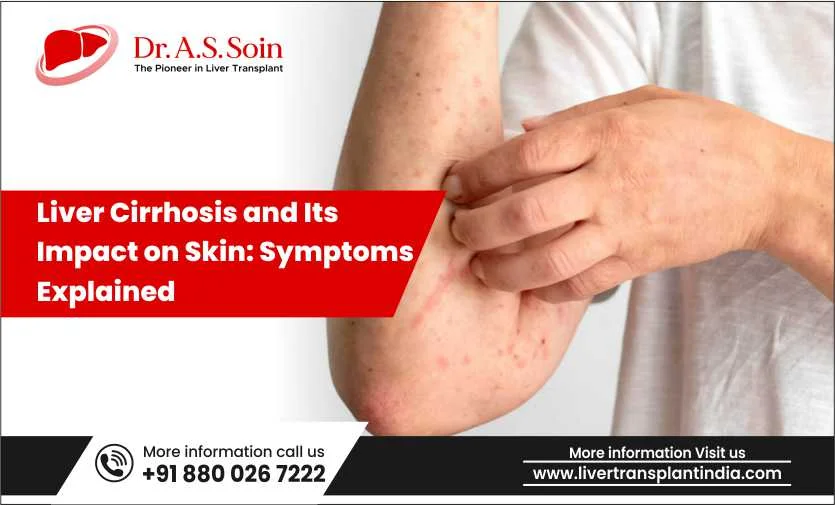Ever noticed unexplained skin changes—yellowing, itching, or tiny spider-like veins? We often dismiss these as minor issues, but what if they signal something deeper?
Your skin isn’t just a protective barrier; it’s a mirror reflecting your internal health. While many associate skin problems with allergies or aging, they can also point to serious conditions like liver cirrhosis.
Cirrhosis silently damages the liver, but its warning signs often appear on the skin first. Understanding these symptoms of liver cirrhosis can help detect liver disease early, leading to better outcomes.
If your skin is trying to tell you something, it’s time to listen. Let’s explore the skin-related signs of cirrhosis and what they mean for your health.
Table of Contents
ToggleUnderstanding Liver Cirrhosis
Cirrhosis is the result of chronic liver damage where healthy liver tissue is replaced by scar tissue. This scarring disrupts the liver’s ability to function effectively. Common liver cirrhosis causes include:
- Chronic Alcohol Consumption: Long-term alcohol abuse can severely damage liver cells.
- Viral Hepatitis: Persistent infections like hepatitis B, C, and D can lead to liver inflammation and scarring.
- Metabolic Dysfunction-Associated Steatotic Liver Disease (MASLD): Formerly known as nonalcoholic fatty liver disease, this condition arises when fat accumulates in the liver without significant alcohol intake.
- Autoimmune Diseases: Conditions where the body’s immune system attacks liver cells.
- Genetic Disorders: Diseases like hemochromatosis (iron overload) and Wilson’s disease (copper accumulation) can lead to cirrhosis.
How the Liver and Skin are Connected
The skin is our body’s largest organ, and it often reflects our overall health. Since the liver is responsible for detoxifying and metabolizing various substances, any impairment in its https://viceinvestigacion.utch.edu.co/ function can lead to a buildup of toxins and changes in hormone levels. This imbalance can manifest as various skin conditions. Here are some of the main ways the liver influences skin health:
- Detoxification Failure: When the liver is damaged, toxins that are normally processed and eliminated can accumulate in the bloodstream. These toxins may then deposit in the skin, causing irritation, rashes, or other changes.
- Hormonal Imbalances: The liver helps to break down hormones. In cirrhosis, the impaired breakdown can lead to an excess of certain hormones, which might result in skin issues.
- Nutritional Deficiencies: A healthy liver is crucial for absorbing and storing vitamins and minerals. Cirrhosis can result in deficiencies of essential nutrients like vitamin A, vitamin D, and zinc, all of which are critical for healthy skin.
- Immune System Alterations: The liver is also involved in regulating the immune system. When cirrhosis develops, the immune response may become altered, sometimes triggering skin inflammation and other dermatological conditions.
Common Skin Symptoms Linked to Liver Cirrhosis
Patients with liver cirrhosis might notice several skin changes. Here’s a detailed look at the common symptoms of liver cirrhosis:
Spider Angiomas
Spider angiomas, also known as spider nevi, are small, dilated blood vessels that appear near the skin’s surface. They have a red center with radiating small capillaries that look like spider legs.
- Why They Occur
Increased estrogen levels due to impaired liver function cause dilation of small blood vessels near the skin.
- What to Look For
You might notice these marks on the face, neck, upper chest, or arms. Although they are usually harmless, their presence can indicate underlying liver issues, especially if they are numerous.
Palmar Erythema
Palmar erythema is characterized by redness on the palms of the hands. The redness is usually symmetrical and can sometimes be accompanied by a burning sensation or warmth.
- Why It Occurs
Liver damage causes hormonal imbalances and increased blood flow to the hands.
- What to Look For
If you notice persistent redness on your palms without an obvious cause (like sun exposure or a reaction to a chemical), it could be a sign of liver problems, particularly cirrhosis.
Jaundice
Jaundice is a condition where the skin, eyes, and mucous membranes turn yellow. This happens when there is an accumulation of bilirubin, a yellow pigment produced during the normal breakdown of red blood cells.
- Why It Occurs
The liver’s inability to break down bilirubin leads to its buildup in the bloodstream.
- What to Look For
Yellowing of the skin, especially noticeable on the face, hands, and feet, as well as the whites of the eyes, can be an early sign of liver cirrhosis. If you experience these changes, it is important to seek medical evaluation.
Pruritus (Itching)
Many patients with liver cirrhosis experience persistent, sometimes severe itching without an obvious rash. This symptom can be both uncomfortable and distressing.
- Why It Occurs
The buildup of bile salts in the bloodstream due https://aula.nuevohorizonte.edu.pe/ to impaired bile excretion is believed to be a major cause of pruritus. These bile salts deposit in the skin and trigger an inflammatory response, leading to itching.
- What to Look For
If you have persistent itching that doesn’t respond to usual treatments, and it occurs alongside other symptoms of liver dysfunction, it might be related to liver cirrhosis.
Dry Skin and Flaking
Dry, flaky skin can be another indicator of liver problems. The skin may feel rough and look dull, sometimes with noticeable scaling.
- Why It Occurs
Nutritional deficiencies, particularly in vitamins and essential fatty acids, are common in liver cirrhosis. Additionally, the buildup of toxins in the bloodstream can disrupt normal skin hydration and repair mechanisms.
- What to Look For
Regular moisturization may help, but if you find that your skin is persistently dry and flaking along with other liver-related symptoms, it’s a sign that your liver may be struggling.
Hyperpigmentation
Hyperpigmentation refers to areas of the skin becoming darker than the surrounding skin. In the context of liver disease, this often appears as blotchy or uneven patches.
- Why It Occurs
The exact mechanism isn’t fully understood, but it is thought to be related to hormonal imbalances, metabolic changes, and the body’s response to chronic inflammation.
- What to Look For
If you notice dark spots or patches developing on your skin, particularly if they are accompanied by other signs of liver dysfunction, it’s worth discussing with a healthcare provider.
Easy Bruising and Bleeding
Cirrhosis affects the liver’s ability to produce clotting factors, leading to increased bruising and easy bleeding.
- Why It Occurs
Reduced clotting factor production makes even minor injuries result in large bruises.
- What to Look For
Frequent bruises, prolonged bleeding from minor cuts, or bleeding gums while brushing teeth.
Nail Changes (Terry’s Nails and Muehrcke’s Lines)
Liver cirrhosis often causes nail abnormalities such as white nails with a narrow pink band at the tip (Terry’s nails) or horizontal white bands across the nails (Muehrcke’s lines).
- Why It Occurs
Protein deficiencies and changes in blood circulation impact nail growth and color.
- What to Look For
Fading pink color at the nail tip, white bands across the nails, and increased nail fragility.
Swelling (Edema and Ascites)
Fluid retention can cause swelling in the legs (edema) and abdomen (ascites).
- Why It Occurs
The liver produces less albumin, a protein that regulates fluid balance, leading to the accumulation of fluid in tissues.
- What to Look For
Shiny, tight skin due to fluid buildup, swelling in the legs, and an enlarged abdomen.
Bilirubin Deposits (Xanthomas and Xanthelasmas)
Liver dysfunction can lead to fatty deposits under the skin, particularly around the eyes.
- Why It Occurs
High cholesterol levels due to liver damage contribute to the formation of these yellowish plaques.
- What to Look For
Soft, yellowish lumps on the eyelids, elbows, or hands that do not fade over time.
Lifestyle and Management Strategies
If you are experiencing skin changes along with other symptoms of liver disease, early diagnosis and management are critical. Here are some strategies that may help manage these symptoms of liver cirrhosis:
Medical Evaluation and Regular Check-Ups
The first step is to consult with a healthcare professional if you notice any unusual skin changes along with other symptoms like jaundice, unexplained itching, or bruising. Regular liver function tests and imaging studies can help monitor the health of your liver and catch cirrhosis in its early stages.
Diet and Nutrition
A balanced diet can make a significant difference in managing liver cirrhosis. Focus on:
- High-quality proteins: Lean meats, fish, and legumes can help support liver repair.
- Fruits and vegetables: Rich in antioxidants, these can reduce inflammation and support overall health.
- Whole grains: These provide essential fiber and nutrients that assist in maintaining a healthy metabolism.
- Healthy fats: Sources such as olive oil, nuts, and avocados can be beneficial.
Limiting alcohol and avoiding foods high in saturated fats are also key to reducing further liver damage.
Skin Care Regimen
For skin-specific care:
- Moisturize regularly: Use hypoallergenic moisturizers to help combat dryness and prevent itching.
- Mild cleansers: Harsh soaps can strip the skin of essential oils. Opt for gentle cleansers to maintain skin barrier function.
- Sun protection: Protecting your skin from excessive sun exposure can prevent further damage and pigmentation changes.
- Avoid irritants: If you’re prone to itching or rashes, try to avoid known irritants and allergens that could worsen the symptoms.
Medication and Therapies
In some cases, medications to manage symptoms such as itching or hormonal imbalances may be necessary. Always consult your doctor before starting any new medication. Additionally, certain topical treatments might be recommended by a dermatologist to address specific skin issues.
Monitoring and Managing Complications
Since liver cirrhosis can lead to a range of systemic issues, including fluid buildup in the abdomen (ascites) and bleeding disorders, it’s crucial to work closely with your healthcare team. Regular follow-ups help in adjusting treatments and managing any emerging complications that might indirectly affect your skin health.
Advancements in Treatment and Research
Medical research is continuously evolving, and there are promising developments in both the treatment of liver cirrhosis and the management of its skin manifestations. Some of the current areas of focus include:
- Antifibrotic Therapies: These aim to slow or even reverse the formation of scar tissue in the liver. Although still in experimental stages, such treatments hold promise for future management of cirrhosis.
- Nutritional Interventions: Researchers are looking into targeted nutritional therapies to help replenish specific vitamin and mineral deficiencies caused by liver dysfunction.
- Advanced Skin Therapies: Newer dermatological treatments that combine both topical and systemic approaches may offer relief from the skin symptoms of liver cirrhosis, such as persistent itching and rashes.
- Liver Transplantation: For patients with advanced cirrhosis, liver transplantation remains a vital option. With improvements in surgical techniques and post-operative care, the outcomes have become more favorable, offering patients a new lease on life.
These advancements underscore the importance of early detection and comprehensive care, allowing patients to benefit from both current treatments and future breakthroughs.
Conclusion
The skin serves as a window to our internal health, often revealing signs of underlying conditions like liver cirrhosis. Recognizing these dermatological manifestations can lead to timely medical intervention, potentially slowing disease progression and improving quality of life.
If you or a loved one are experiencing any of the symptoms discussed, it’s crucial to consult with a healthcare professional specializing in liver diseases. Dr. A.S. Soin, a renowned liver transplant surgeon, has extensive experience in managing liver conditions. Seeking expert advice can provide clarity and guide you toward the best course of action for your health.








